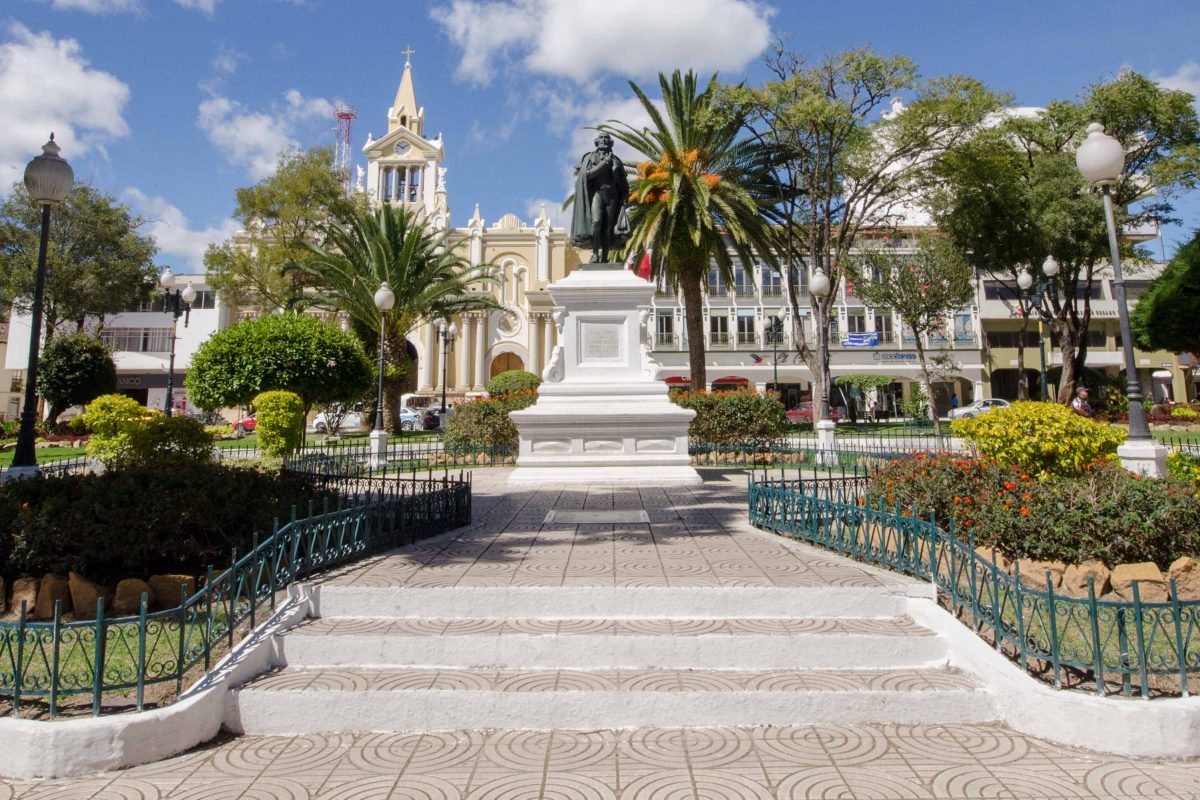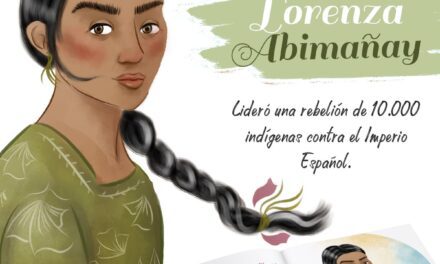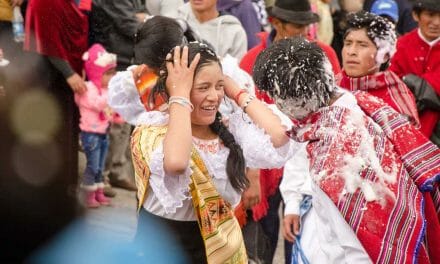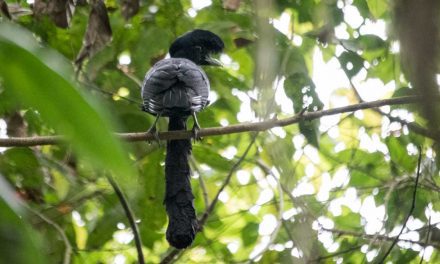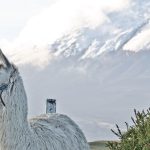Local festivals in Ecuador are the heart and soul of many communities. They are found in the highest Andean towns and the smallest jungle enclaves, in tiny fishing villages and large cities like Quito, Cuenca, and Guayaquil. Many are well advertised and openly invite international tourists. Some smaller festivals are best visited with an Ecuadorian friend or a local guide to avoid making cultural faux-pas.
Unfortunately, the smaller the location, the harder it is to gather good information about exact dates and times of parades and festivals. If you are an adventurous traveler with time on your hands, your best bet is to arrive a few days before the “official” holiday and to ask locals about dates and times. Festivals that do not fall on national holidays are most often celebrated on the closest weekend.
But if you don’t have time to hang out and learn, then our continually growing list of annual festivals in Ecuador might give you an idea for your next vacation to the mainland. We have started to add links to community Facebook pages to help you with your planning. If you find a dead link, please let us know!
January
The Diablado de Píllaro, Tungurahua Province
The Diablado de Píllaro has ancient roots harking back to Spanish Colonial times. Participants don elaborate, horned masks and red clothing as local musicians, dancers, and civic organizations accompany them through the city streets. Parades take place each afternoon from January 1-6th.
La Fiesta de los Reyes Magos (Three Kings Day), all Ecuador
Look for Three Kings festivals throughout Ecuador, especially throughout the Andean Sierra, on the first few days in January, culminating on the actual Epiphany, January 6th. Processions usually include the baby Jesus with parents, Mary and Joseph, and the Three Kings, often on horseback. They are accompanied by musicians and traditional dancers.
Jondachi River Festival, Tena, Napo Province
Jondachi Fest is a grass-roots, volunteer-driven community river festival and whitewater kayak competition that takes place in Tena, Ecuador in mid-January.
February
Carnival (Mardi Gras), all Ecuador
Carnival (Mardi Gras) is always celebrated 47 days before Easter, a holiday which falls on the first Sunday after the full moon following a spring equinox. The towns of Guaranda and Guamote are known for some of the most colorful and traditional parades in the high Sierra. Be warned that Carnival festivals in Ecuador are raucous celebrations. If you attend a procession, be prepared to be sprayed with water from water guns or party foam. Even walking the local neighborhoods can be fraught with danger as the occasional bucket of water is tossed from an overhead window down onto unsuspecting pedestrians. Expect festivities and parades to take place for the entire four-day weekend with the height of celebrations falling on Monday. This holiday, also called the Feriado de Carnival, is one of the busiest vacation weekends of the year so make sure to make reservations for popular destinations, especially for beach holidays along the Pacific Coast.
March
Mushak Nina (Andean New Year), all Ecuador
Mushak Nina is often a part of the Pawkar Raymi celebrations that fall in and around the March equinox, March 20 or 21. Most of these celebrations are small and attract only local residents. Many are held at Museos de Sitios (outdoor archeology museums) with ties to pre-Incan cultures of ancient Ecuador, like Cochasquí or Ingapirca .
Semana Santa (Holy Week), all Ecuador
Semana Santa is a week full of activity in Ecuador, beginning on Palm Sunday and ending on Easter Sunday. It is especially renowned in the capital city, Quito. Processions, artisan fairs, special events revolving around food or music, crop up throughout the region. Check out the Palm Sunday procession that arrives around 10 am in the Plaza San Francisco, the Holy Thursday church visits or the candlelight procession, the Good Friday procession where purple-robed penitents accompany Jesus del Gran Poder for a 5-kilometer route in the Historic Center.
April
Fiesta de Kasama, Santo Domingo de los Tsáchilas Province
In early April, the province of Santo Domingo de los Tsáchila celebrates the Fiesta de Kasama, a celebration of the local New Year. Events include dance, theater, music in formal and informal settings.
Fiesta Agricola (Agricultural Fair), Riobamba, Chimborazo Province
In celebration of the importance of farming to the Chimborazo Province, the town of Riobamba holds the Fiesta Agricola to celebrate local agriculture.
Fiesta de Chonta, Archidona, Napo Province
The Fiesta de Chonta revolves around the importance of the palm fruit, chonta, to the Napo Province and the native peoples of the Oriente. The harvest of this fruit begins in February and generally ends in April. Locals make chicha de chonta, a fermented beverage that will be featured throughout the celebratory weekend.
May
Fiesta de la Chirimoya, Puná, Guayas Province
Every year in May, residents of the Isla Puna celebrate the harvest of the chirimoya, a fruit sometimes called the Custard Apple in English. While the chirimoya is the highlight of the festival, locals use this festival to promote local cuisine, especially fresh seafood dishes, and the indigenous culture of the region in song and dance.
Batalla de Pichincha, Quito, Pichincha Province
The commemoration of the famous Battle of Pichincha celebrates the Ecuadorian national day of independence from Spain. A colorful gathering of traditionally-uniformed cadets from the three military academies takes place at the Tomb of the Unknown Soldier that overlooks the city of Quito. Attendance in the stands is limited to invited guests but onlookers are known to stand nearby to see this traditional military display.
Corpus Christi, all Ecuador
Towards the end of May into mid June, the religious holiday of Corpus Christi is celebrated in communities throughout the Ecuadorian Sierra. While these are not large gatherings, the small processions and festivals that crop up in the smallest towns provide a unique view into local customs. Here are a few places you might like to check out:
Píllaro, Cotopaxi Province – information often found on the GAD Twitter Feed
June
Inti Raymi (June Solstice), Ecuadorian Sierra
The June Solstice is widely celebrated throughout the Ecuadorian Andes but the Imbabura Province offers some of the most iconic and colorful processions on the mainland. In the south, the archeology site of Ingapirca holds an annual celebration as well. For smaller communities, the June solstice is often celebrated on the weekend that falls closest to June 21.
Fiestas de San Juan, Imbabura Province
Closely related to the celebration of Inti Raymi, the Fiestas de San Juan combine Catholic practices with native Andean traditions. Processions can include the colorful Diablo Humo and other characters typical of Inti Raymi while celebrating the Saints Day of San Juan.
Fiestas de San Pedro, Cayambe, Pichincha Province
The Inti Raymi festivities in the Pichincha Province include the celebration of another Saints Day, San Pedro. In the town of Cayambe, cowboys from the surrounding ranches parade down the city streets in the Paseo del Chagra. This week-long festival includes a beauty pageant, parades, artisans fairs, and local foods.
July
Fiesta Toros Populares de Píllaro, Tungurahua Province
July 29th is Founders Day in Píllaro and includes traditional bullfighting as well as parades of musicians, folk dancers, and locals in native costume. Remember, events can be scheduled for several weeks around the anniversary date.
For more information, try the GAD Píllaro Twitter Feed or Facebook Feed.
Paseo de Chagra, Machachi, Pichincha Province
Chagras are cowboys who wear chaps of alpaca-hide and leather hats. They work the local ranches in the high paramo of the Pichincha Province near the Volcano Cotopaxi. Each year, they gather in Machachi to parade down local streets and to pit themselves against one another in tests of skill at the local rodeo.
For more information, check out the Asociación Cofradía del Chagra (ACOCHA) on Facebook.
Fiestas de Zaruma, El Oro Province
The city of Zaruma in Southern Ecuador holds events for the entire month of July in honor of their Patron Saint, the Virgin of Carmen. Events can take place all month although July 16th is the actual Saints Day. Events often include the National Festival of Coffee and an Agricultural Fair celebrating the wide variety of products that are grown in and around Zaruma.
For more information, check out the Official Facebook Page for Tourism in Zaruma.
Fiestas Julianas, Guayaquil, Guayas Province
The city of Guayaquil celebrates the Saints Day of their patron Saint, Santiago el Mayor, on July 25th. Celebratory events are not constrained to a single day but take place throughout the month of July. Look for food festivals, beauty pageants, parades on land and river, and music events.
The best place to find more information is Guayaquil es mi Destino on Facebook.
August
Primer Grito de la Independencia, Pichincha Province and All Ecuador
The First Cry of Independence is a holiday similar to Independence Day in the United States. On August 10, 1809, a group of Criollo citizens of the Audencia Real de Quito, announced the local rebellion to overthrow Spanish-colonial rule. While this was a seemingly inconsequential act by a small group of people, it was the first time any person in South America had committed to overthrowing the colonial power.
Today, the holiday is celebrated as a three-day weekend. While some locations may hold celebratory events, especially if they have strong connections to a military community, it isn’t the norm to have civic events. Rather, families often head to the beach for vacation.
Virgin del Cisne, Loja Province
In mid-August, the province of Loja celebrates the feast day of the Virgin of Cisne, colloquially known as La Churona because of her curly locks of hair. On August 15th, the actual feast day, there are events held at the Santuario de Nuestra Señora de El Cisne. We suggest checking out this video to see the Sanctuary in its full glory. Then, the sainted statue is carried from the sanctuary in a procession that takes place through the day and night until she reaches the Cathedral in Loja.
The city of Loja generally celebrates the Virgin on the weekend following 15 August, though it is always best to check for exact dates. Events that honor the Virgin can continue all the way into early September when the city holds the Feria de Loja.
For more information, try this website: cuandopasa.com and this Facebook page Virgen Del Cisne.
Fiesta Kako Wiiñaë, Shushufindi, Sucumbios Province
The Secoya Nation, an indigenous tribe located near the Aguarico River in Sucumbios, celebrates the beginning of the new year on the 24th and 25th of August. This celebration includes a local parade with school and civic groups dressed in native costumes. Purification rituals include the use of a hallucinogenic plant native to the region. Please limit your participation to public events where a clear invitation to tourists is offered.
September
Fiesta del Yamor, Otavalo, Imbabura Province
The Fiesta del Yamor of Otavalo highlights yamor, a traditional drink made of seven different varieties of corn. The weeklong festival provides plenty of opportunities to try yamor and several other local food and drink specialties. Festivities generally reach their high point on the first weekend in September and include a local parade with floats as well as folk dancers and musicians playing traditional Andean music. Participants come from all over Ecuador to join the parade.
For more information, try this website dedicated to the festival
Fiesta de Jora, Cotacachi, Imbabura Province
The Fiesta de Jora in Cotacachi celebrates corn and the production of chicha de jora. Activities include music, parades, exhibits, and sports competitions. Look for events to be scheduled early to mid-September.
For more information, try this Facebook page: Fiestas de Cotachaci.
Fiesta del Maiz, Sangolqui, Pichincha Province
This huge festival is a little like the county fairs found around the United States. Farmers from the surrounding region converge in the town of Sangolqui, just outside Quito, bringing local products like cheeses and yogurt as well as their best horses, chickens, and cows. The highlight of the week is the traditional Corn Parade which includes folk dancers, musicians, and beautifully decorated floats.
For more information, try this Twitter feed: https://twitter.com/mruminahui
Feria Internacional del Banano, Machala, El Oro Province
This celebration along the coast of Southern Ecuador is everything banana! Part agricultural fair, part celebration of the banana and its importance to the Ecuadorian economy, this festival includes a week of activities towards the end of September.
Killa Raymi (September Equinox), Ecuadorian Sierra
The September Equinox celebrations are called Killa Raymi in the Ecuadorian Andes. Many of the other festivals in Ecuador taking place during this month have roots in this solar event. It is a traditional celebration of planting new corn and other crops. Look for festivals near Museos de Sitios (open-air archeology museums) like Ingapirca and Cochasqui as well as in towns with strong, indigenous traditions.
Fiesta de Mama Negra, Latacunga, Cotopaxi Province
The Fiesta de Mama Negra in the Cotopaxi Province originated after an eruption of the Volcano Cotopaxi. Local residents credited the Virgen de las Mercedes for protecting the city from the eruption and began an annual day of thanks. Today, the festival includes a spectacular parade highlighting a black Virgin Mary, Mama Negra. She represents the blending of native Ecuadorian, African, and European traditions. A similar event, hosted by the city, also takes place in November.
October
Guayaquil Independence Day, Guayas Province
On October 9, 1820, Guayaquil claimed independence from Spain. Every other year, this is a national holiday in Ecuador (exchanged with the Independence Day of Cuenca in November). But even those years that the holiday isn’t celebrated on a national level, residents of Guayaquil celebrate with a civic parade and a month full of special activities like art exhibitions, film festivals, and more. Expect this celebration to be magnified in 2020 as Guayaquil will celebrate their bicentennial.
Cacería del Zorro, Ibarra, Imbabura Province
The Cacería del Zorro is a horse race that takes place every year in early October. The winner from last year’s race dons the infamous fox tail that fellow race participants must steal before the finish line to take the new title. Several categories from youth to professional take place throughout the day. The morning of the race begins with a parade in town; race participants then make their way on a traditional track that includes some challenging opportunities for rider and horse before arriving at the race track on the shores of Yaguarcocha. Many local clubs sell tickets that include a celebratory event later in the evening. (Oct 1-7, 2018)
November
Día de los Difuntos, all Ecuador
The Day of the Deceased celebrations of mainland Ecuador are similar to the Day of the Dead celebrations of other countries in North and South America. Families visit local cemeteries and share food near the graves of their ancestors. Traditional foods include guaguas de pan and colada morada. While the actual holiday falls on November 2, many communities also celebrate on November 1. Parks and plazas often fill up with pop-up fairs and carnivals.
Dia de Independencia de Cuenca, Azuay Province
November 3, 1820, the city of Cuenca declared independence from Spain. Every other year, this is a national holiday in Ecuador (exchanged with the Independence Day of Guayaquil in October). There are hundreds of planned special events that take place throughout the month with most taking place the first weekend in November. Many include recognition of the Day of the Dead taking place on November 1st and 2nd. Expect this celebration to be magnified in 2020 as Cuenca will celebrate their bicentennial.
Fiestas de Latacunga, Cotopaxi Province
The city of Latacunga celebrates its independence on the 11th of November. Sometimes, they combine this holiday with the Day of the Dead Festivities and hold events for the first week in November. Often, this celebration is also called Mama Negra as the famous representation of the Black Virgin Mary makes an appearance at many events. However, this civic celebration is not to be confused with the indigenous festival that takes place in September.
December
Read more about December in Ecuador in this article: Celebrating Christmas in Ecuador
Fiestas de Quito
The founding of Quito took place on December 6, 1534. In the week proceeding this big celebration, hundreds of celebratory events are planned throughout the city, from bullfights to beauty pageants, block parties to music festivals. The final day will be full of unique firework displays that are best enjoyed in the neighborhoods where they happen.
Pase del Niño, all Ecuador
The Pase del Niño, or the Walk of the Child, is a Catholic tradition where locals take part in a huge procession and accompany the baby Jesus on a walk through the city streets. While many towns hold events in the days before Christmas, this event traditionally takes place on Christmas Eve. The most well-known Pase del Niño in the country takes place in the historic center of Cuenca where the procession begins at Iglesia del Corazón de Jesús and finishes at the Iglesia del Carmen de la Asuncion.
Kapak Raymi
Kapak Raymi is a festival held on or near the December Solstice, December 21st. While celebrated in many Andean communities, the most well-known celebration takes place in Saraguro, a Quichua town located a couple of hours south of Cuenca in the Loja Province. Parades and a festival-like atmosphere take over the town for a good week with the most iconic celebrations taking on the weekend closest to the 21st while not competing with Christmas Eve or Christmas Day.
Fiesta de Inocentes, Atuntaqui, Imbabura Province
Between the day after Christmas and New Years Eve, the community of Atuntaqui in the Imbabura Province celebrates the Fiesta de Inocentes. The actual Day of Innocents is a little like April Fool’s Day of the United States. But this festival includes a parade on New Year’s Eve and incorporates many of the New Year traditions found throughout Ecuador, like the viudas, men dressed as widows of the Old Year, and the burning of effigies.
New Year’s Eve, All Ecuador
Throughout Ecuador, New Year’s Eve is celebrated with a passion unlike any other holiday. During the day, viudas (widows), actually men dressed as women, take to the streets to ask for donations. Families purchase their monigote (effigy) or make their own from old clothes stuffed with flammable items. Starting in the afternoon at many places of work, people begin to burn the monigotes as way to get rid of all that was bad in the last year. Families tend to burn monigotes just before midnight, jumping over the dying flames through the smoke as a way to purify oneself for the New Year. In some cities, especially Guayaquil, the monigotes are often HUGE. Many cities, like Salinas, have professional fireworks while in others, fireworks are a more casual affair and set off in the middle of the streets.
Are there other festivals in Ecuador you want us to share?
Readers who would like to submit suggestions, please fill out the following form:
Event Submission Form
[gravityform id=”16″ title=”true” description=”true”]


